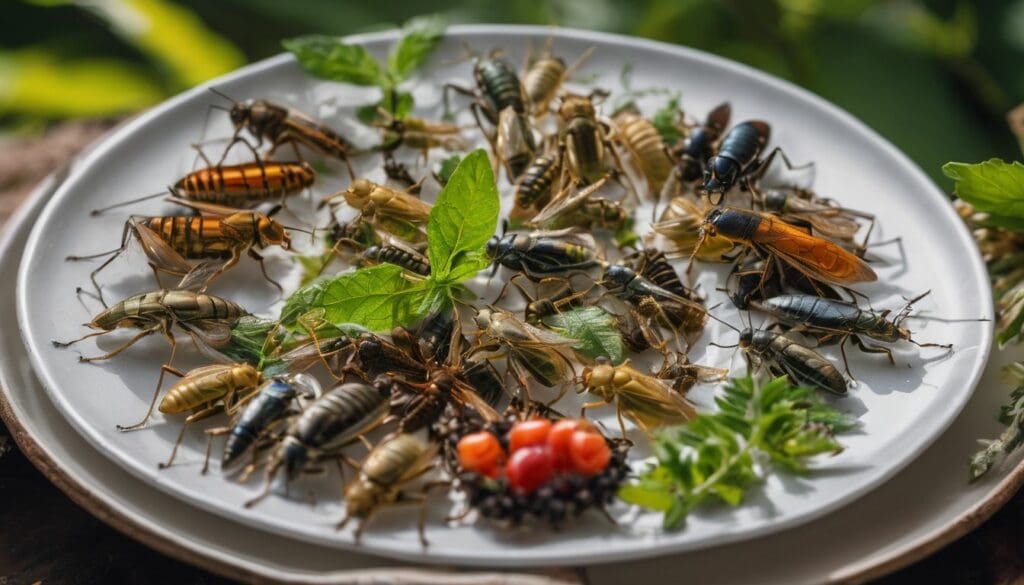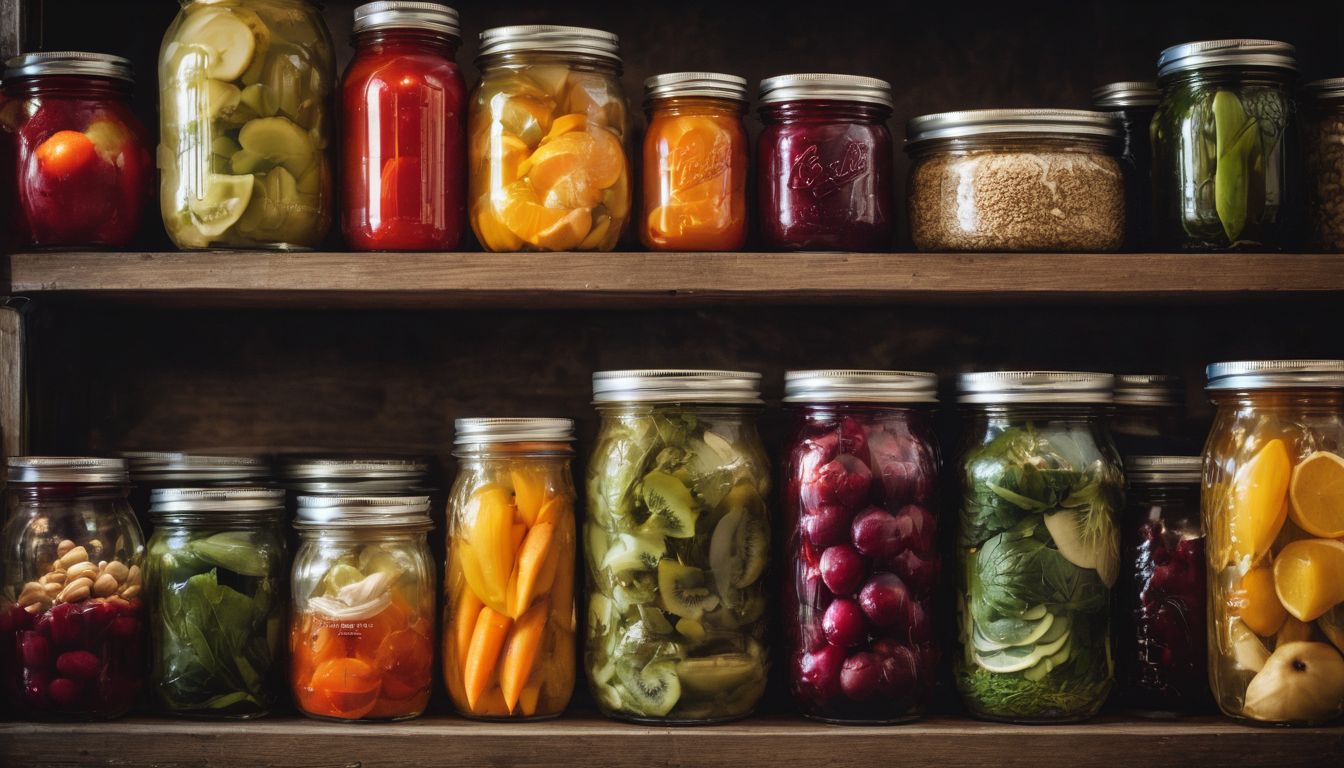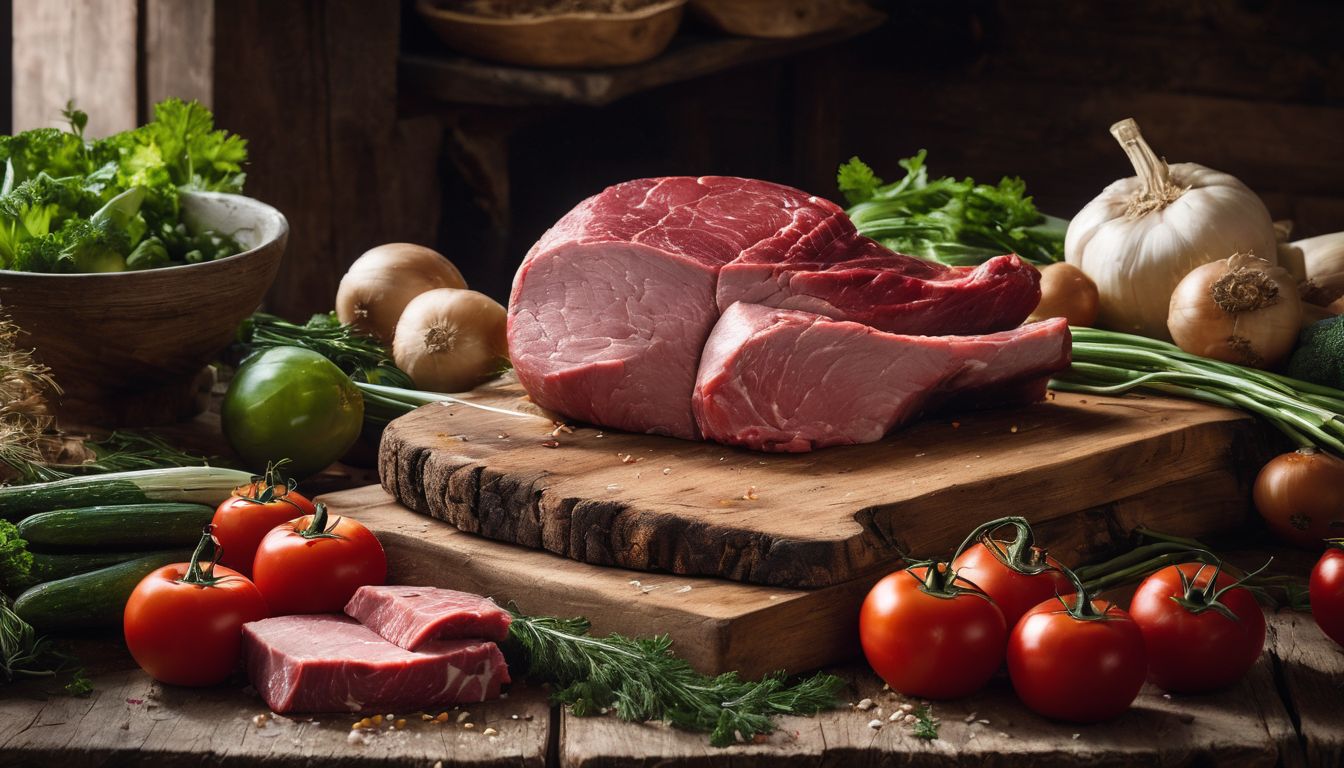As we search for sustainable food, edible insects buzz into the spotlight. They’ve been a staple in many cultures for centuries. This post will unwrap how munching on bugs could help tackle your protein needs and environmental concerns together.
Dive in to discover a tiny yet mighty food revolution!
Key Takeaways
- Edible insects are packed with protein, vitamins, and minerals, providing a sustainable alternative to traditional meat. They require less space, water, and food than livestock.
- Insect farming can offer a solution to the global need for food security due to its low environmental impact and contribution to reduced greenhouse gas emissions.
- Traditional methods of preparing insects include roasting, frying or boiling; these enhance flavour and have been passed down through generations in many cultures.
- Commercial processing allows insects to be turned into flours and oils for use in familiar foods like energy bars and pasta. This helps overcome negative attitudes around eating whole bugs.
- The future is bright for edible insects as demand increases globally; they represent an innovative way to meet sustainability goals within the food industry.
The Historical and Cultural Importance of Edible Insects as a Protein Source
Throughout history, various cultures have embraced the consumption of insects as a valuable protein source, utilising traditional methods of preparation to incorporate them into their diets.
This practice has been sustained for generations and continues to be an integral part of many cultural cuisines worldwide.
Human consumption throughout history
People have been eating insects for thousands of years, finding these small creatures a valuable source of protein. Societies across the globe, from Asia to Africa and Latin America, regularly include bugs in their diets.
Drawn by their abundance and nutritional profile, our ancestors recognised the benefit of what many now consider novelty food. They harvested swarms of locusts, gathered termites after heavy rains, or picked caterpillars off wild plants.
Insect farming may seem like a modern idea but it stems from traditional practices that date back centuries. Eating insects is deeply embedded in some cultures where they are revered not just as sustenance but as culinary delights.
As we explore alternative protein sources today, these sustainable protein traditions offer invaluable insights into more environmentally friendly diets. Moving forward, understanding how our predecessors harnessed such benefits steers us towards greener choices that impact both personal health and environmental sustainability.
Now let’s delve into the traditional methods used to prepare these nutritious insects for consumption.
Traditional methods of preparation
Families worldwide have long relied on traditional methods of preparation for edible insects. In many cultures, insects are roasted, fried, or boiled to enhance their flavour and texture.
For example, in parts of Africa and Asia, termites are commonly sun-dried before being ground into a powder or added whole to stews. In Mexico, chapulines (grasshoppers) are typically pan-fried with garlic, lime, and chilli flakes to create a crispy snack.
Similarly, in Thailand and Cambodia, crickets are deep-fried until they become crunchy.
In addition to these techniques, indigenous communities smoke certain insect species to preserve them for consumption during times of scarcity. This age-old wisdom has been passed down through generations as part of cultural traditions that honour the nutritional value and sustainability of consuming insects.
The Nutritional Value and Benefits of Edible Insects
Edible insects are a rich source of protein, vitamins, and minerals, often comparable to traditional sources like meat and fish. Additionally, their cultivation requires significantly less water and land compared to conventional livestock, making them an environmentally sustainable option for food security.
Comparison of nutritional value to traditional protein sources
In the quest for sustainable protein, edible insects present a remarkable nutritional profile when juxtaposed with conventional sources. Below is a comparison detailing their value.
| Nutritional Aspect | Edible Insects (100g, average) | Beef (100g) | Chicken (100g) |
|---|---|---|---|
| Protein | 40-75g | 26g | 27g |
| Fat | 20-50g | 15g | 14g |
| Energy | 450-650 kcal | 250 kcal | 239 kcal |
| Iron | 4-20 mg | 2.6 mg | 1.2 mg |
| Zinc | 6-10 mg | 5.3 mg | 1.0 mg |
| Vitamin B12 | 5-10 µg | 2.6 µg | 0.3 µg |
| Fibre | 5-10g | 0g | 0g |
This table illustrates insects as a superior source of essential nutrients, including protein, fat, and micronutrients. They surpass beef and chicken in several key areas, making them an attractive alternative for the environmentally conscious.
Economic and environmental benefits
Edible insects offer economic and environmental benefits that align with conservation efforts. Insect farming requires less land, water, and feed compared to traditional livestock farming, reducing the environmental impact.
Additionally, insect protein production emits fewer greenhouse gases, making it a more sustainable option for environmentally conscious individuals. As the demand for edible bugs grows globally, investing in insect-based diets can promote food security while supporting conservation efforts.
The nutritional value of insect protein presents economic advantages as well. Insects provide a cost-effective source of high-quality protein with essential amino acids, contributing to sustainable food production.
Promoting food security
Incorporating edible insects into diets contributes to promoting food security. Insects are a highly sustainable protein source, requiring fewer resources and producing lower greenhouse gas emissions compared to traditional livestock.
This makes them an environmentally friendly option that can help alleviate food shortages and reduce the strain on natural resources. Embracing insect consumption as a viable dietary choice can provide an additional layer of resilience to our global food system, ensuring greater access to nutritious sources of protein for all.
Moreover, integrating insect-based foods can diversify the available protein sources, especially in regions where access to conventional proteins is limited. By normalising cultural attitudes towards edible insects and encouraging sustainable insect production practices, communities can enhance their ability to withstand fluctuations in agricultural yields and economic instability.
Challenges and Solutions for Incorporating Edible Insects into Modern Diets
Sustainable insect production is a challenge that needs to be addressed, along with food safety concerns and negative attitudes towards consuming insects. However, innovative solutions such as using insects in food and beverage formulations are being explored to overcome these challenges.
Sustainable insect production
- Utilising organic waste as feed for insects, minimising environmental impact.
- Implementing vertical farming practices to reduce land use and water consumption.
- Applying natural pest control methods to ensure the health of insect colonies.
- Incorporating efficient harvesting techniques to maximise yield while minimising energy consumption.
- Developing innovative packaging and distribution methods to reduce food waste and carbon footprint.
Food safety concerns
Sustainable insect production is crucial to ensuring the safety of edible insects as a protein source. Here are some food safety concerns to consider:
- Microbiological hazards: Insects can carry harmful bacteria and parasites, which may pose health risks if not properly handled and processed.
- Chemical contaminants: Insects can accumulate toxins from their environment, such as pesticides or heavy metals, which can be transferred to humans upon consumption.
- Allergenic potential: Some individuals may have allergic reactions to specific insect proteins, highlighting the need for allergen labelling and identification.
Overcoming negative attitudes towards consuming insects
Addressing negative attitudes towards consuming insects can be achieved through education and awareness campaigns. By highlighting the nutritional benefits of insect protein and discussing its role in promoting food security, misconceptions about insect consumption can be challenged.
Additionally, integrating insects into familiar food products, such as energy bars or pasta, allows individuals to experience the benefits of insect protein without directly consuming whole insects.
Engaging with chefs and food experts to create delicious recipes that incorporate insect ingredients also helps in changing perceptions and encouraging acceptance of insect-based diets.
Promoting entomophagy as a sustainable and environmentally friendly dietary choice further contributes to altering negative attitudes. Emphasising the ecological advantages of utilising insects for food production can sway public opinion.
The Growing Global Demand for Edible Insects
As the demand for sustainable protein sources continues to rise, commercial processing methods and the potential use of edible insects in food and beverage formulations are gaining traction.
To learn more about this growing trend, read on in our blog!
Commercial processing methods
Insect protein is increasingly being incorporated into modern diets through various commercial processing methods. These methods include drying, grinding, and extraction to create insect-based flours, powders, and oils for use in food and beverage formulations.
Advanced techniques such as extrusion have also been developed to enhance the texture and palatability of insect-based products, making them more appealing to consumers.
Additionally, innovative companies are exploring sustainable approaches to mass rearing insects for large-scale production to meet the growing global demand for this alternative protein source.
Potential for use in food and beverage formulations
Edible insects hold great potential for use in food and beverage formulations, offering a sustainable protein source with promising culinary applications. Their high protein content makes them an ideal ingredient for creating nutritious and environmentally friendly products.
With innovative processing techniques, insect-based flours and pastes can be incorporated into various food items such as energy bars, pasta, and smoothies, enriching them with essential nutrients while reducing the reliance on traditional protein sources.
In addition to their nutritional value, edible insects contribute to diversifying flavour profiles in food and beverage formulations. The unique taste of edible insects adds a twist to recipes, appealing to adventurous consumers seeking new gastronomic experiences while supporting sustainable agricultural practices.
Conclusion: The Future of Edible Insects as a Sustainable Protein Source
The increasing demand for edible insects as a sustainable protein source is driving innovation in food production. Consumers are embracing the nutritional benefits and eco-friendly aspects of insect-based diets.
With advancements in sustainable insect production, entomophagy is poised to play a significant role in promoting food security and environmental conservation. The future of edible insects as a protein source looks promising, offering a viable solution to the growing global demand for alternative sources of nutrition.
FAQs
1. What are the benefits of eating insects for protein?
Eating insects offers a nutritional value high in protein, and they’re environmentally friendly compared to other meat sources.
2. Why is insect protein becoming popular for human consumption?
Insect-based diets are growing trends because they’re more sustainable and have a lower environmental impact than traditional meats.
3. Can anyone follow an insect-based diet?
While many people can enjoy the benefits of an insectbased diet, some might face limitations due to dietary restrictions or personal preference.
4. What does it mean to be an entomophagist?
An entomophagist is someone who regularly includes insects as a source of protein in their diet, embracing this eco-conscious trend.





